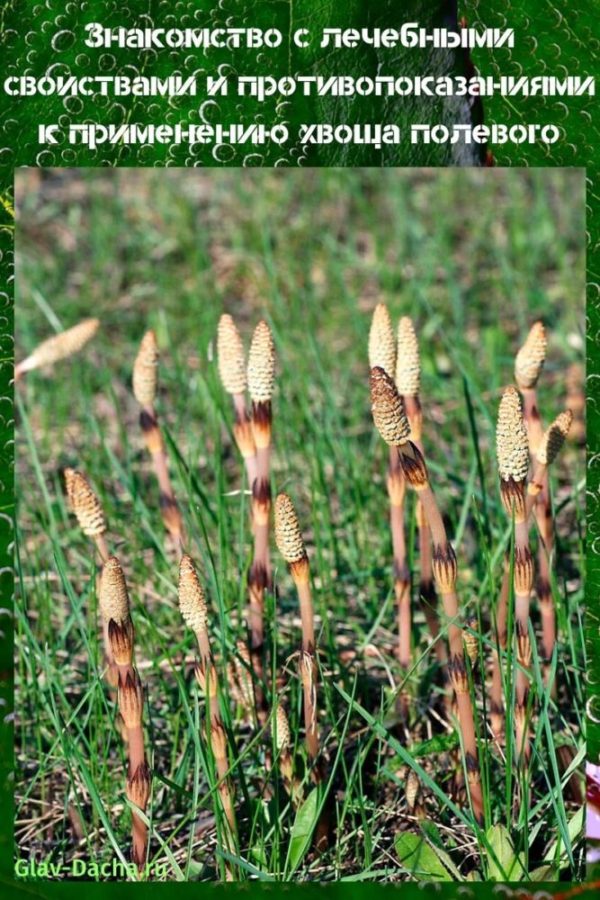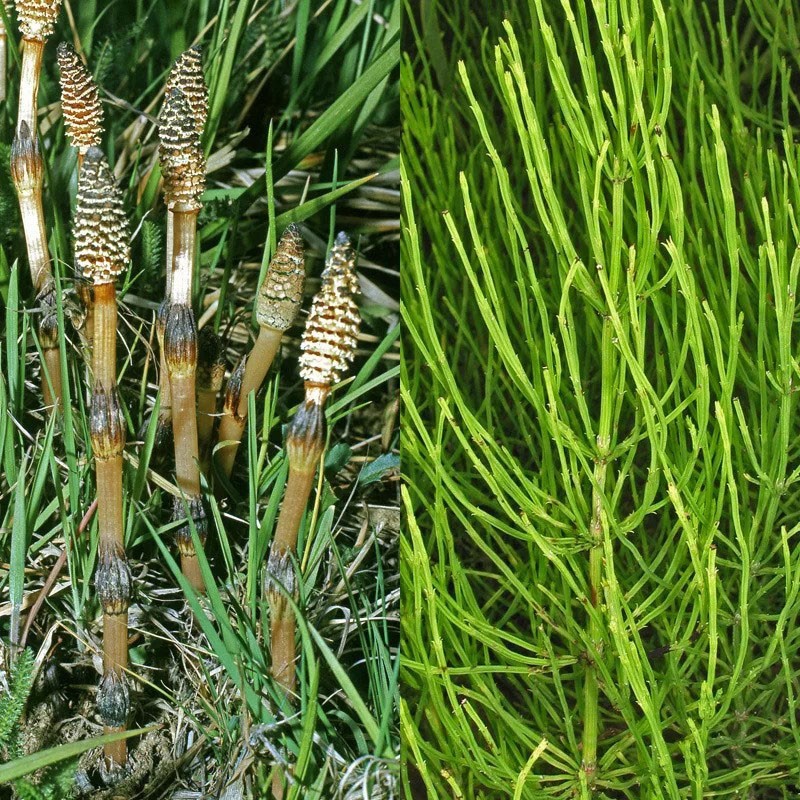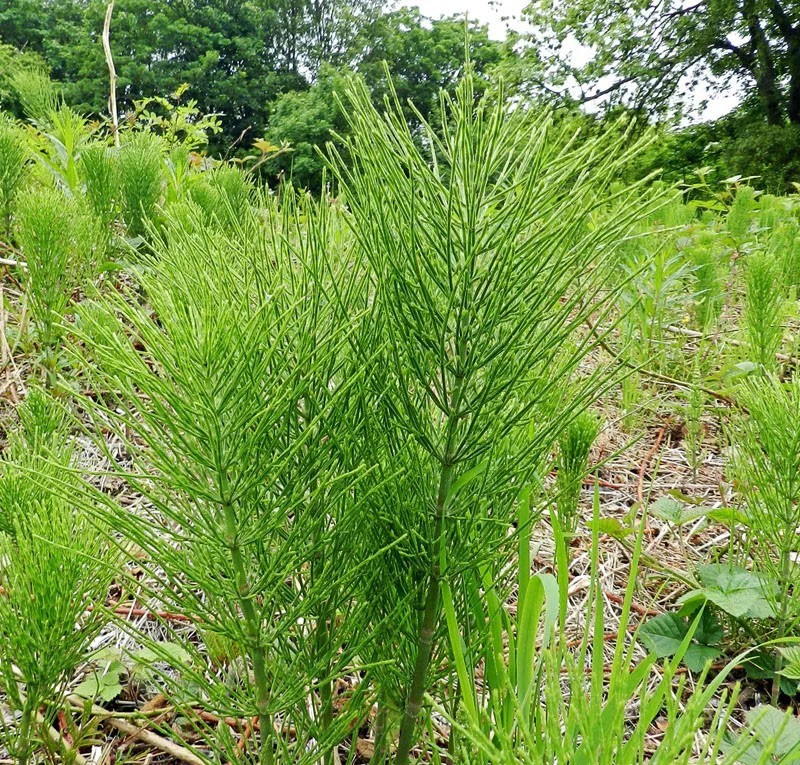Acquaintance with the medicinal properties and contraindications to the use of field horsetail
 Knowing the medicinal properties of the field horsetail and the contraindications to the use of the plant for certain diseases, you can use the plant with maximum benefit to improve your health. If you wish, you can find a healing herb growing in the field or not far from housing in the countryside.
Knowing the medicinal properties of the field horsetail and the contraindications to the use of the plant for certain diseases, you can use the plant with maximum benefit to improve your health. If you wish, you can find a healing herb growing in the field or not far from housing in the countryside.
Description of the plant

Plant height approximately 40-50 cm. Dimorphic shoots:
- vegetative - erect, green, from 1.5 to 5 mm in diameter, with twigs and a spiky top;
- generative - shoots of brown or pinkish color, with triangular leaf teeth, most often, after maturation of the spores, they tend to die off.
Horsetail grows in many regions of the world. In Russia, it can be found everywhere, with the exception of desert and semi-desert zones, as well as regions of the Far North. There are especially many of these plants in the floodplains of northern rivers, the outskirts of swamps, meadows, forests, and pastures.
 In the chemical composition of horsetail, in addition to higher fatty acids and vitamin C, carbohydrates and organic acids, including malic, chicory, aconitic and glyceric acids, are found. High content of silicic acid, potassium salts. There are steroids, saponins, several phenolcarboxylic acids and their derivatives, carotenoids.
In the chemical composition of horsetail, in addition to higher fatty acids and vitamin C, carbohydrates and organic acids, including malic, chicory, aconitic and glyceric acids, are found. High content of silicic acid, potassium salts. There are steroids, saponins, several phenolcarboxylic acids and their derivatives, carotenoids.
In early spring, only vegetative shoots are collected from horsetail plants, at this time they are very juicy and green.
 The stems are cut off at the very surface of the soil, collected in bunches and suspended in a shaded, well-ventilated place. A sign of a well-dried plant is the fragility of the side branches.
The stems are cut off at the very surface of the soil, collected in bunches and suspended in a shaded, well-ventilated place. A sign of a well-dried plant is the fragility of the side branches.
Medicinal properties of field horsetail and contraindications for use
 In spring, generative shoots are eaten. These are pistils known to all. They are eaten fresh and boiled, used in salads and okroshka. Many people love pestle-filled pies. With the help of horsetail, needlewomen dye wool in yellow-green shades of varying intensity. Furniture is polished with dry powder from the stems.
In spring, generative shoots are eaten. These are pistils known to all. They are eaten fresh and boiled, used in salads and okroshka. Many people love pestle-filled pies. With the help of horsetail, needlewomen dye wool in yellow-green shades of varying intensity. Furniture is polished with dry powder from the stems.
The useful properties of the horsetail were noticed for a very long time. In China, this plant was used for tuberculosis. The great Avicenna recommended its juice as an effective wound-healing agent, and also used infusions made on wine for tumor diseases of the stomach and liver. He believed that the plant helps with bloody diarrhea and dropsy.
Nicholas Culpeper, a famous English physician, astrologer and pharmacist who lived in the 17th century and studied the healing properties of plants, believed that with the help of a wine extract of horsetail, you can expel kidney stones, get rid of coughing fits, and lower body temperature in case of colds.
Use in modern medicine
 The aerial parts of the horsetail were included in the 8th, 9th and 11th editions of the State Pharmacopoeia of the USSR. The drug "Marelin", intended for the treatment of urolithiasis, is made on the basis of horsetail extract.
The aerial parts of the horsetail were included in the 8th, 9th and 11th editions of the State Pharmacopoeia of the USSR. The drug "Marelin", intended for the treatment of urolithiasis, is made on the basis of horsetail extract.
In the form of extracts, decoctions and granules, the plant is used as a well-known diuretic, effective in ascites and the treatment of the urinary tract, as well as:
- with ischemia;
- immunodeficiency states;
- with the appearance of edema in pregnant women;
- in dental practice - with increased formation of dental calculi;
- in dermatology - with psoriasis, seborrhea, dermatitis, eczema;
- with systemic scleroderma, alopecia.
In clinical trials, horsetail-based drugs have proven themselves well in the complex treatment of chronic cholecystitis and pancreatitis, allergic dermatoses. There is experimental evidence of the presence of antihypoxic properties in the entire aerial thicket of the plant.
In medical practice, horsetail juice is prescribed to patients with chronic bronchitis or bronchial asthma, taking into account all the medicinal properties and contraindications of the field horsetail (see photo below).
The use of horsetail in traditional medicine has a fairly broad focus. Decoctions and infusions from it in Bulgaria are used as a proven general tonic for such serious diseases as:
- pulmonary tuberculosis;
- anemia;
- ulcer of the duodenum and stomach;
- colitis;
- epilepsy;
- gout;
- arthritis;
- myocarditis;
- rhinitis;
- stomatitis and a number of other diseases.
Horsetail extract is used in the production of dietary supplements, except for packages with dry grass, it is produced in the form of tea bags, capsules containing oil.
But the horsetail has not only benefits, but also harm. For example, decoctions of the plant cannot be used for chronic kidney disease, as they can cause irritation. Horsetail remedies for nephritis are contraindicated. They can also not be taken orally by pregnant and lactating women, children.
Horsetail decoction is successfully used as a means of preventing diseases in plants. Due to the silicic acid contained in horsetail, plants are more resistant to fungal diseases such as rust, powdery mildew and even some pests, especially the invasion of spider mites.
The use of horsetail in cosmetology
 Horsetail extract is a valuable remedy that strengthens the hair structure, it becomes silky and shiny. The condition of skin tissues improves, their regeneration, the content of collagen and elastin increases in them. The extract belongs to biological products, it is used as an ingredient with medicinal properties. It is a natural anti-aging agent that contains ultraviolet filters. It controls the production of sebum, and suppresses the development of cancer cells.
Horsetail extract is a valuable remedy that strengthens the hair structure, it becomes silky and shiny. The condition of skin tissues improves, their regeneration, the content of collagen and elastin increases in them. The extract belongs to biological products, it is used as an ingredient with medicinal properties. It is a natural anti-aging agent that contains ultraviolet filters. It controls the production of sebum, and suppresses the development of cancer cells.
 Horsetail creams keep the skin elastic and protect against age-related changes. With continued use, the skin becomes smoother and rejuvenated. Silicon strengthens the walls of the capillaries, narrows the existing pores. Horsetail cosmetics have a pronounced anti-cellulite effect. There are also creams for edema and stretch marks.
Horsetail creams keep the skin elastic and protect against age-related changes. With continued use, the skin becomes smoother and rejuvenated. Silicon strengthens the walls of the capillaries, narrows the existing pores. Horsetail cosmetics have a pronounced anti-cellulite effect. There are also creams for edema and stretch marks.
In addition, horsetail extract has a mild antimicrobial effect. It inhibits the development of Salmonella, Escherichia coli and even Staphylococcus aureus. Sometimes horsetail is used in cosmetics as a thickener or absorbent powder.
Horsetail oil is very effective in treating vascular networks, with its help you can get rid of bags under the eyes, swelling of the facial contour. The oil improves the general condition of the skin, relieves various inflammations, eliminates acne.
Who is cosmetics and horsetail preparations suitable for?
 Cosmetics containing horsetail should be the first choice for people whose skin is dry, dull, dehydrated and flaky. Also, the object of application can be called mature skin or with a tendency to premature aging.Since horsetail components have a slight drying effect, cosmetic preparations can be used to reduce inflammation in acne.
Cosmetics containing horsetail should be the first choice for people whose skin is dry, dull, dehydrated and flaky. Also, the object of application can be called mature skin or with a tendency to premature aging.Since horsetail components have a slight drying effect, cosmetic preparations can be used to reduce inflammation in acne.
Horsetail preparations have great potential in the treatment of skin conditions. Especially in the fight against such severe forms of abscesses as boils and carbuncles.
 This is a reliable remedy for brittle nails and delamination. With constant use of products containing horsetail, they are noticeably strengthened, and white spots disappear on the nail plates. It is worth purchasing oral hygiene products that include horsetail extract. In this case, the gums will stop bleeding, the aphthae (ulcers) will disappear in the mouth. Photos of horsetail, its medicinal properties and contraindications are usually published on the labels and stickers of cosmetics, so you need to choose them carefully.
This is a reliable remedy for brittle nails and delamination. With constant use of products containing horsetail, they are noticeably strengthened, and white spots disappear on the nail plates. It is worth purchasing oral hygiene products that include horsetail extract. In this case, the gums will stop bleeding, the aphthae (ulcers) will disappear in the mouth. Photos of horsetail, its medicinal properties and contraindications are usually published on the labels and stickers of cosmetics, so you need to choose them carefully.
For tonsillitis, inflammation of the tonsils caused by staphylococci or beta-hemolytic streptococcus, you should systematically rinse your mouth and throat with a liquid containing horsetail extract.
Wintering horsetail with very tough stems grows in the Moscow region. If you run them over the surface of the steel, small scratches will remain. This is due to the fact that the plant contains an incredible amount of silica, which is concentrated in the outer cells. In the old days, a polishing agent was made from it.